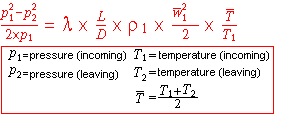Technical information - SF Pressure Drop Help
SF Pressure Drop
Help
Principles
Technical Information
Pressure drop:
Pressure drop in pipes is caused by:
1.) Friction
2.) Vertical pipe difference
3.) Changes of kinetic energy
Calculation of pressure drop caused by friction in circular pipes
First we calculate the Reynolds-Number:

If Reynolds number < 2320, than we have laminar flow, else we have turbulent flow.
Now we calculate the pipe friction number:
Pipe friction number at laminar flow:

Pipe friction number at turbulent flow:

Now we can calculate pressure drop in circular pipes:

Calculation of pressure drop caused by friction in fittings etc.
To calculate pressure drop in fittings we use resistance coefficients normally. The resistance coefficients are in the most cases found through practical tests. If the resistance coefficient is known we can calculate the pressure drop:

Calculation of pressure drop caused by vertical pipe difference
Pressure drop caused by vertical pipe difference we calculate with the formula:

Calculation of pressure drop caused by changes of kinetic energy
Pressure drop caused by changes of kinetic engergy we calculate with the formula:

The element "Dyn. pressure change" calculates these pressure changes. Normally you input the dimension of begin and end of the whole pipe.
Pressure drop in gases and vapor
Compressible fluids expands caused by pressure drops (friction) and the velocity will increase. Therefore is the pressure drop along the pipe not constant.
SF Pressure drop calculates these pressure drops with an approximate equation (pressure drop at arbitrary heat transfer):

We set the pipe friction number as a constant and calculate it with the input-data. The temperature, which is used in the equation, is the average of entrance and exit of pipe.
You can calculate pressure drops of gases with the same formula as liquids if the relativ change of density is low (change of density/density = 0.02).